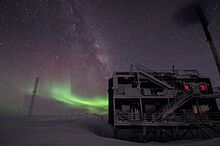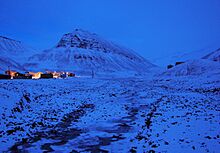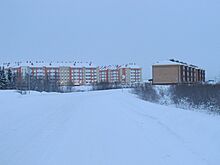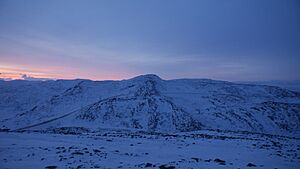Polar night facts for kids
The polar night is a cool natural event that happens in the very northernmost and southernmost parts of Earth. Imagine a time when the Sun stays hidden below the horizon for more than 24 hours! This only occurs inside the polar circles, which are special lines on the globe. The opposite of polar night is called midnight sun, where the Sun stays above the horizon for more than 24 hours.
Even during polar night, it's not always completely dark. This is because of something called twilight. Twilight is the time when the Sun is just below the horizon, and its light still brightens the sky. There are different kinds of twilight. For example, "civil twilight" is when the Sun is only a little bit below the horizon, and you can still see things clearly outside. As the Sun sinks lower, it gets darker, moving into "nautical twilight" and then "astronomical twilight." True night is when the Sun is so far below the horizon that its light doesn't reach us at all.
Because Earth's atmosphere bends sunlight, the polar day (when the sun is always up) actually lasts a bit longer than the polar night. The polar circles are found at about 66.5 degrees latitude. When it's daytime in the Arctic Circle (the north), it's nighttime in the Antarctic Circle (the south), and vice versa!
Contents
Understanding Polar Night
The length of the polar night changes depending on how far north or south you are. It can be as short as 24 hours just inside the polar circles. But at the actual North Pole or South Pole, it can last for almost half a year!
It's important to remember that "polar night" doesn't always mean total darkness. Most places experiencing polar night will actually have some form of twilight. This is because sunlight bends over the horizon, making the sky brighter than you might expect. The middle of the day, even during polar night, is usually the brightest time. If there are lots of clouds, the sky will look even darker.
Types of Polar Twilight
There are different levels of darkness during the polar night, depending on how far the Sun is below the horizon. These are called different types of polar twilight.
Civil Polar Twilight
Civil polar twilight happens in areas above 72°34' North or South. During this time, the Sun is below the horizon all day, but not by much (less than 6 degrees). This means there's no true daylight, but there's still enough light for most outdoor activities. You can see clearly outside, even at midday.
However, if there are thick clouds, places like the coast of Finnmark in Norway (around 70° North) can have a much darker "day." Sometimes, street lamps stay on even at noon!
Here are some approximate dates for civil polar twilight in the Northern Hemisphere:
- 68° North: around December 9 to January 2
- 70° North: around November 26 to January 16
- 72° North: around November 16 to January 25
And in the Southern Hemisphere:
- 68° South: around June 7 to July 3
- 70° South: around May 24 to July 18
- 72° South: around May 14 to July 27
Some people find that long periods with less natural light can make them feel tired or a bit down. They might use special bright lights to help them feel more energetic. Even during the brightest part of civil twilight, the natural light isn't as strong as a sunny day.
Nautical Polar Twilight
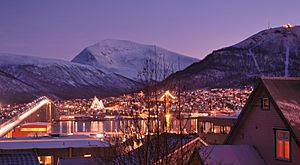
Nautical polar twilight occurs at latitudes between about 72°34' and 78°34' North or South. Here, the Sun is between 6 and 12 degrees below the horizon all day. During this time, you can still see the general shapes of objects outside at midday. However, it's too dark for detailed outdoor tasks.
For example, the town of Longyearbyen in Svalbard, Norway, experiences nautical polar twilight from about November 11 until January 30. Dikson, in Russia, has nautical polar twilight from about December 6 to January 6.
Astronomical Polar Twilight
Astronomical polar twilight happens at latitudes between about 78°34' and 84°34' North or South. This is when the Sun is between 12 and 18 degrees below the horizon all day. At midday, the sky is dark enough to see many stars, just like a normal night. However, there might still be a faint glow on the horizon where the Sun is.
Some places that experience astronomical polar twilight include:
- The Norwegian town of Ny-Ålesund, Svalbard, from about December 12 to 30.
- The Canadian research base of Eureka, Nunavut, from about December 2 to January 8.
- Alert, Nunavut, the northernmost settlement in Canada, from about November 19 to January 22.
True Polar Night
A true polar night is when it's completely dark all day long. The Sun is more than 18 degrees below the horizon, so there's no astronomical twilight at all. During this time, even the dimmest stars are visible throughout the entire 24-hour period.
True polar night only happens at very high latitudes, above roughly 84°34' North or South. This is very close to the actual poles. The only permanent settlement at these extreme latitudes is the Amundsen–Scott South Pole Station in Antarctica. The people working there are completely isolated for months during winter.
The South Pole experiences true polar night from about May 11 to August 1. The North Pole experiences it from about November 12 to January 28.
The Polar Sun Cycle
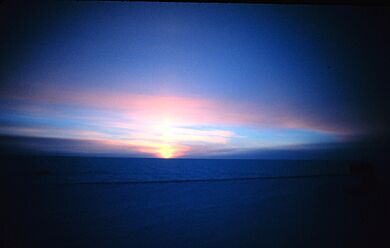
At Earth's poles, the Sun's cycle is very different from what most of us experience. If you were at the North or South Pole, a "day" (from one highest point of the Sun to the next) would actually last for one whole Earth year! This is because the Sun slowly rises and sets over many months, not just 24 hours. It marks the change between the long polar night and the long polar day.
How Polar Night Affects People
Scientists have studied how living through the long polar night affects people.
In Tromsø, Norway, a city at 69 degrees north, the polar night lasts for about two months, from mid-November to mid-January. A study looked at how sleeping patterns changed for people over 40. It found that men sometimes had more trouble sleeping in the fall and winter. However, overall, people's sleep didn't change much throughout the year. This might be because Tromsø uses a lot of artificial light, which helps make up for the lack of natural sunlight.
Another study was done with men working at Belgrano II Base, an Argentine research station in Antarctica. This station is at 77 degrees south, so its polar night lasts for four months. The study found that people generally slept for longer periods in the summer than in the winter. They also noticed that people's sleep schedules sometimes shifted more in winter, like having "social jetlag."
A third study looked at the well-being of Korean crew members at two research stations in Antarctica. Some crew members experienced difficulties with their sleep or mood during the early winter months. These studies show that the long polar night can affect people's sleep and how they feel. However, people living in these regions often find ways to adapt, using artificial light and maintaining routines.
See also
 In Spanish: Noche polar para niños
In Spanish: Noche polar para niños


